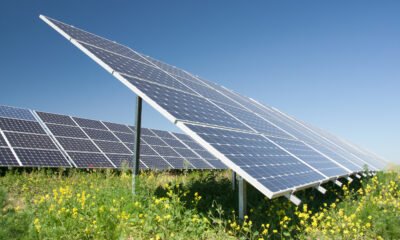

Environment
Wind and Sun Power February Renewables Output – New Data Published
The next Scottish Government needs to establish a comprehensive new strategy to help businesses and consumers reduce their demand for electricity, environmentalists have said.
The call by WWF Scotland came as the group published analysis of wind and solar data provided by WeatherEnergy showing that for the month of February:
- Wind turbines in Scotland provided 929,417MWh of electricity to the National Grid, enough to supply, on average, the electrical needs of 109% of Scottish households (2.64 million homes) – this represents an increase of 5% compared to that of February 2015, when wind energy provided 886,347MWh.
- Wind turbines generated enough electricity to supply 100% or more of Scottish homes on 19 out of the 29 days of February.
- Scotland’s total electricity consumption (i.e. including homes, business and industry) for February was 2,289,105MWh. Wind power therefore generated the equivalent of 41% of Scotland’s entire electricity needs for the month.
- For homes fitted with solar PV panels, there was enough sunshine to generate an estimated 53% of the electricity needs of an average household in Dundee, 49% in Aberdeen, 42% in Edinburgh and Glasgow, and 41% in Inverness.
- For those homes fitted with solar hot water panels, there was enough sunshine to generate 52% of an average household’s hot water needs in Dundee, 48% in Aberdeen, 38% in Glasgow, 35% in Inverness, and 34% in Edinburgh.
WWF Scotland’s director Lang Banks said: “It’s quite amazing to think that during February wind turbines alone quietly provided over forty per cent of Scotland’s total electricity needs. However, the shift to a low-carbon society not only calls for an increase in the proportion of the nation’s demand met by renewables but also a national strategy to reduce demand overall.
“Research has shown that reducing electricity demand by even one percent a year would make it easier and cheaper for Scotland to de-carbonise its electricity system, hit its climate targets and secure widespread social and economic benefits. This need to pay close attention to our demand for power is why we want the next Scottish Government to establish a comprehensive strategy to help businesses and consumers reduce their power usage, leading to lower bills and climate emissions.”
Karen Robinson of WeatherEnergy said: “It was another strong month for renewables, with total wind power output up slightly on the same period last year. And despite it still being officially winter, for the thousands of homes across the country fitted with solar panels, sunshine provided a third or more of an average households’ electricity or hot water needs. As we move through spring toward summer we can expect solar power output to rise, helping households to increasingly avoid having to rely on fossil fuels for their hot water or electricity needs.”


 Environment9 months ago
Environment9 months agoAre Polymer Banknotes: an Eco-Friendly Trend or a Groundswell?

 Environment11 months ago
Environment11 months agoEco-Friendly Home Improvements: Top 7 Upgrades for 2025

 Features8 months ago
Features8 months agoEco-Friendly Cryptocurrencies: Sustainable Investment Choices

 Features10 months ago
Features10 months agoEco-Friendly Crypto Traders Must Find the Right Exchange





























